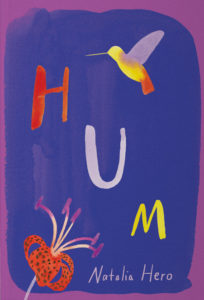
This Little Everything: Trauma’s Persistent Presence in Natalia Hero’s Hum
- Posted by Augur Blog
- On May 24, 2019
- 0 Comments
- book review, CanLit, hum, natalia hero, rape culture
Reviewed by Kate Finegan
The hummingbird in Natalia Hero’s debut novel, Hum, is persistent, inescapable, an ever-present reminder of what the narrator has endured, even when she doubts her own experience. In reliving that night, trying to remember if she said “No” or only meant to, her thoughts are cut short. She “can’t stay with one thought for more than a second without the bird acting up.”

This short novel, in which a hummingbird materializes after the narrator is raped, represents a brilliant, seamless marriage of form and content. The first-person narrative, with its short chapters, takes the reader into a changed mind, one that is unsure of itself and its reality and, importantly, what is needed to move forward. The narrator has a caring roommate who encourages her to join a support group, but even still, reaching out is a struggle: “And I think Help. I need Help. But I don’t say that, because you don’t say that. You don’t say you need Help unless you know what Help you need.” Similarly, the narrator doesn’t quite know what the bird needs from her, and when the bird does not get what it needs, it stabs her neck with its long, sharp beak.
The narrator characterizes the bird as “This little Everything that follows me everywhere,” which is apt. It is a product of trauma but can sometimes be a comfort. It was born of harm but requires tender care. It is separate from the narrator but also intimately connected to her. It isolates her, but her support group hums with other survivors’ birds. It is a paradox—a flighty, unpredictable thing. Each reader will bring their own understanding of trauma to this novel, and that is the power of the metaphor-made-literal. The bird is a character, and as such, readers can interpret the character and its relationship to the narrator through their own lens. This is not a one-size-fits-all narrative of surviving trauma.
Soon after reading Hum, I picked up Whatever Gets You Through: Twelve Survivors on Life after Sexual Assault, edited by Stacey May Fowles and Jen Sookfong Lee. The editors note in their introduction that “In fiction, there’s a grievous act, a perpetrator caught, and a consequence delivered.”
The essay collection aims to disrupt that narrative, focusing instead on the myriad ways in which survivors cope—how: “In the years following sexual violence, many survivors learn to live differently. They learn to adapt to a trauma that attaches itself to them, building a new existence around that black hole that makes its presence known in every choice, every intimate act, every hope and dream.”
Hum immerses the reader in this multifaceted process; it shows how the narrator’s life and her relationships change as she accommodates this new buzzing companion. The bird illuminates and complicates the trajectory of pain and overcoming that we often see in survivor narratives built around redemption.
Reading this book feels, somehow, like an act of hope. As Fowles and Lee note, survivor’s stories teach us that “there is a way forward, even if it’s not the prescribed or sanctioned one we’re used to. Even if it’s not acceptable, or pretty, or inspiring.” Hum shows that there is a way through, without relying on familiar tropes or allowing the humming to get any quieter, without allowing the bird to simply flit away. The narrator in Hum learns, “That This can exist after That. It just looks a little different than you might think.”
Natalia Hero. Hum. Published in 2018. Metatron Press. ISBN: 978-1-988355-15-3, 104 pp. Can $14.00.
CHECK OUT OUR OTHER REVIEWS HERE.




0 Comments